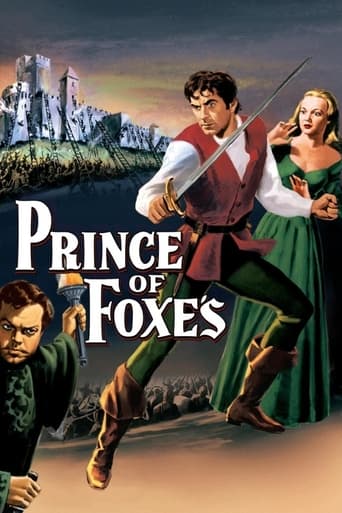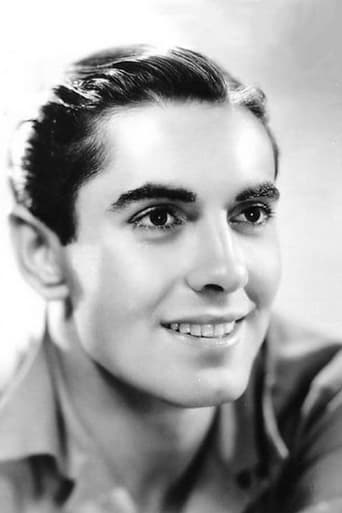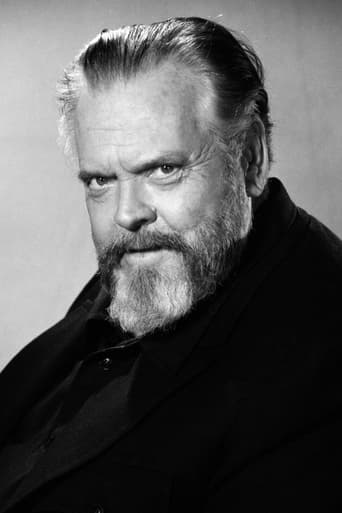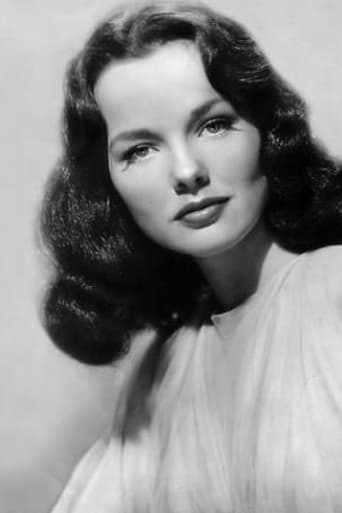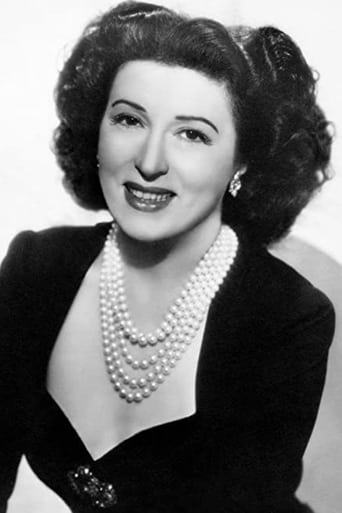krocheav
Curiously shot in B/W this superbly produced (on location in Italy) epic is quite special in many ways. Expensive sets, costumes, and handpicked cast are equally supported by an intelligent screenplay from Milton Krims - based on Samuel Shellabarger's expansive novel. Richly nuanced performances (what a pity Orson Welles went off on a tangent instead of committing to acting!). These performers make the crisp dialog sparkle and the action scenes are recreated with all their terrifying realism. Direction is first class with Alfred Newman underscoring in his expected professional style. Almost never seen today, this films DVD release is to be commended for several interesting features. One for the Film Score lovers is the separate track given for the music score. If only other discs would offer this marvellous feature. I came late to this film so, was pleasantly surprised to find it far more enthralling than at first anticipated. Quality for history and cinema buffs of all ages. This is yet more evidence to support colourising of fine motion picture art - many films were just not able to be shot in colour at the time of production - so the academy and other misguided 'film' makers are cheating us out of enjoying these important gems in the colour they deserve. The argument they put up against colorizing is simply out of date in this computer age! Move with the artistic abilities of the times. I'm sure the populace would be far happier (do a consensus) if you kept your outmoded ideas to yourselves. I'm not saying colorize the noir classics like 'Maltese Falcon' etc but, musicals and costume epics need color and with the technology available and people wanting them in color - why not?
Deedee
For me, Tyrone Power hit his stride as a major actor in his post WWII years, though towards the end of his contract with 20th Century Fox, the material seemed to become quite thin. Fortunately, he redirected his career when he got control of it and was able to do the stage work he loved and to make several terrific films before his untimely death in 1958. In Prince of Foxes, I think his maturity is seen to fine advantage in the role of a world-weary agent of Cesare Borgia. The script, though flawed by several glaring inconsistencies, is literate and makes for an engrossing historical drama. Power is excellent and so is Everett Sloan, a fascinating actor who's great in a dynamic secondary role. He and Power are a fine pairing with a unique chemistry that makes me wish they had done other films together. I can only take Orson Wells in small doses. Here he's just allowed a short time on screen to knit his brows, wrinkle his nose and chew on the scenery, feathers, grapes, his fingers, etc. Prince of Foxes was filmed on location in glorious black and white with a very rich look that I wouldn't change for the world. I had the great good fortune to travel in Italy, including Venice and San Marino (aka Citta Del Monte in the film), about ten years after this was made. Somehow,the cinematographers magically captured the effects of Italy's light and air just as I remember them. The score is lovely and evocative and along with the perfect visuals I get a pang of nostalgia every time I watch it. Prince of Foxes is a favorite that I heartily recommend to lovers of Old Hollywood-style historical drama. The book it's based on is good, too.
drjgardner
This is a film with nearly all the elements to have been a great film, yet somehow it is merely good. We have the great Orson Welles during his "acting" career in Europe, and he is still young and full of vitality. His protegee Everett Sloan is there to support him and steal the scenes when he can, and Tyrone Power is at the top of his game, never more attractive nor more charming. We also have one of my favorite character actors, Felix Aylmer (Polonius in Olivier's "Hamlet").The music and photography are excellent although this film could have benefited from Technicolor. And Director Henry King does his usual great job of giving us action as well as character development.So where does it fall down? It's the female lead. She is terribly miscast and this fails to give us any real involvement at critical points.If you like good acting, this film should be viewed.
romanorum1
On 18 August 1500 in Rome, Cesare Borgia (Orson Wells), the statesman and power-broker of north-central Italy, attends the funeral of his sister Lucrezia's husband (Alfonso d'Aragon). It appears that he was murdered. Borgia leaves the funeral, enters his palace with his entourage, and walks straight to a large cloth wall map of the Italian peninsula. "All Tuscany, the center of Italy from coast to coast, will be ours," he declares. But with his hand he slams the map at the location of the Duchy of Ferrara, a strong city-state south of Venice and Chiogga, which impedes his progress. Borgia's plan is to arrange a marriage between his newly widowed sister and Alphonso, Duke d'Este (James Carney), the heir-apparent of the strongly fortified Ferrara. Borgia asks Andrea Orsini (Tyrone Power) to go on the diplomatic mission to Ferrara to convince Alphonso to marry Lucrezia. By using tact and showing a painting of the sexy Lucrezia to Alphonso, Orsini is successful. Borgia's next elevates Orsini as an ambassador to the mountain castle/territory of Citta del Monte ("Mountain City") in east- central Italy. In reality Orsini's diplomatic mission is to deliver the fortress to Borgia by studying its defenses and also by seducing the much younger wife (Camilla Verano = Wanda Hendrix) of the 70 year- old ruler, Count Marc Antonio Verano (Felix Ayliner). Orsini's girlfriend Angela (Marina Berti) is obviously not happy that he is going away; they drift apart. Borgia tells Orsini that "Women are a gage of man's weakness." He is impressed with Orsini's attributes, but noting that "the flesh is weak," hires the assassin Mario Belli (Everett Sloane) as Orsini's assistant. Belli is given 200 ducats for his loyalty to the ruthless Borgia and to watch Orsini at Citta del Monte and to take action should Orsini get out of hand. But at Citta del Monte Camilla tells Orsini point blank that she does not believe his mission is of an altruistic one, and is weary of his real purpose. Later, the old count tells Orsini that he is playing a deceitful and murderous game. As spring approaches, Orsini is seen painting – his hobby. When he paints Camilla's portrait, she is duly impressed. Along with the spring festival, the change of seasons, there is a symbolic change in Orsini's heart: his moral transformation. Belli has taken notice. When Cesare Borgia decides to attack Camerino (in east-central Italy), the rulers of Citta del Monte refuse to render aid. Now expecting an attack by Borgia, the citizens at Citta del Monte decide to defend themselves behind their magnificent fortifications. Orsini tells Belli that he will assist the count; Belli appears to disagree. Taking the offensive with their cavalry, they inflict a sharp reverse on Borgia's forces in the woodland. Eventually Borgia counterattacks with his full force and catapults, but is repulsed from the castle. But Borgia's forces settle in for a long siege, and after three months the mountain fortress succumbs to terms. Camilla begs Borgia for Orsini's life. At the famous dinner scene celebration, the imprisoned and malnourished Orsini is brought before Borgia, who taunts him. Orsini's mother is brought before him, and she admits that her son Andrea was born a peasant. Borgia wants to imprison Orsini for life, but Belli says that he has a better plan: to free Orsini, but not until after his eyes are gouged out. Borgia agrees. Belli, though, has maintained some loyalty to Orsini, and does not really blind him. Orsini is sent home to live with his mother. Belli visits him, and together they plan a revolt. When the preparations are completed, the signal is given (bell) and the the castle is rushed. There is a fitting sword fight in the shadows near the end between Orsini and his nemesis, Esteban. When it is all over, with Borgia's occupying force defeated (without Borgia present), Andrea Orsini weds Camilla Verano. (The fate of Borgia is uncertain.) The script is intelligent and the acting excellent. Orson Welles, actor par excellence, dominates his scenes as the all-powerful ruthless military leader with derisive humor, wit, and cunning. Everett Sloane is perfect as the unpredictable failed assassin who changes his allegiance several times: "It shall be said among my fellow practitioners in double-dealing that I was the greatest of them all." Tyrone Power gives one of his better performances in character development: the dashing swashbuckler who initially is opportunistic before he too develops a conscience. Even in black and white the cinematography and sets are stunning. The on-location shooting in north Italian regions and Renaissance settings are used to good advantage. (The small republic of San Marino doubles for the fictional Citta del Monte.) The ornate palaces, splendid cathedrals, and the rock-solid walls are all genuine. Also accurately portrayed are the machines of war, like the catapults. The battles – the Renaissance siege of a castle and the cavalry clash in the woods – exhibit realistic aspects. The period costumes dazzle. Underrated! PS: Historical notes – In 1500, the Italian peninsula was divided and ruled by over a dozen small nations and city-states (The Republic of Venice had an empire of islands in the Mediterranean). Earlier, Cesare Borgia's father Roderic (Rodrigo) had emigrated from Spain to the Italian peninsula, having changed his surname from the Spanish "Borja" to the Italian "Borgia." He made his own rules. Never keen on religion, his son Cesare was an effective military ruler (Papal States) in his lifetime. In the end of his extraordinary life he died in an ambush in Spain in 1507; he was only thirty-one years old.
